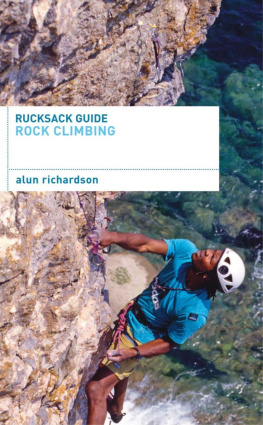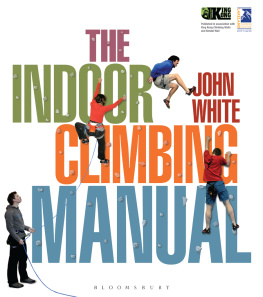

 | Mountaineers Books is the publishing division of The Mountaineers, an organization founded in 1906 and dedicated to the exploration, preservation, and enjoyment of outdoor and wilderness areas.
1001 SW Klickitat Way, Suite 201, Seattle, WA 98134
800.553.4453, www.mountaineersbooks.org |
Copyright 2013 by Matt Samet
All rights reserved. No part of this book may be reproduced or utilized in any form, or by any electronic, mechanical, or other means, without the prior written permission of the publisher.
Printed in the United States of America
Distributed in the United Kingdom by Cordee, www.cordee.co.uk
First edition, 2013
Copy Editor: Laura Shauger
Cover, Design, and Layout: John Barnett/4 Eyes Design
Cover and text illustrations: Mike Tea
Back cover photograph: Lauren McCormick cragging in good style on Porn Star (5.13d), Little Si, Washington.
All photographs by Andy Mann unless credited otherwise
: Matt Samet getting his crag on, on East Jesus Nowhere (5.12d), Wipeyur Buttress,
Devils Head, Colorado. Photo by Todd Leeson.
: Bill Ramsey at Mount Potosi, outside Las Vegas, Nevada
Library of Congress Cataloging-in-Publication Data
Samet, Matt.
Crag survival handbook : the unspoken rules of climbing / Matt Samet.
pages cm
ISBN 978-1-59485-766-9 (trade paper)ISBN 978-1-59485-767-6 (ebook)
1. Rock climbingHandbooks, manuals, etc. I. Title.
GV200.2.S26 2013
796.5223dc23
2013021939
ISBN (paperback): 978-1-59485-766-9
ISBN (ebook): 978-1-59485-767-6
To Kristin and Ivan,
for everything.
To Bob,
my first and most important mentor
on the rocks and in the mountains.
To all the mentors Ive had,
past, present, and future, and to any
good soul who takes the time to teach
a fellow climber.
And to my trusted and cherished
climbing partners, without whom this
sport is nothing.

ACKNOWLEDGMENTS
A BiG THANKS to Mountaineers Books: Kate Rogers, Mary Metz, and all the other great people who helped make this book a reality, and also to Andy Mann for his excellent shots, which comprise the bulk of the photos, and to Mike Tea for his amazing illustrations.
I would also like to thank all the valued contributors and experts who helped me with the writing, research, and art, and without whom I couldnt have pulled this off: the Access Fund, Mike Alkaitis, Susy Alkaitis, Tod Anderson, Brent Apgar, Lisa Aquino, Kristin Bjornsen, Black Diamond Equipment, Tommy Caldwell, Kelly Cordes, Kevin Daniels, Craig DeMartino, Robyn Erbesfield-Raboutou, Herman Feissner, Laurent Filoche, Fixe Hardware, Lynn Hill, Kevin Jorgeson, Joshua Tree National Park, Jim Karn, Jason Keith, Jackie and Jonathan Koehne, Andy Laakman, Ben Lawhon, Leave No Trace, Randy Leavitt, Todd Leeson, Steve Levin, Melissa Lipani, Hugh Loeffler, Maxim Ropes, Metolius Climbing, Mountain Project administrators (www.mountainproject.com), R. D. Pascoe, Eric Pauwels, Petzl America, Rob Pizem, Kolin Powick, Neely Quinn, Bill Ramsey, Bernadette Regan, Corey Rich, Colby Rickard, Brady Robinson, Lucia Hyde Robinson, Rock & Resole, Beth Rodden, Justin Roth, Mikey Schaeffer, Chris Schulte, Jonathan Siegrist, Justen Sjong, Jim Thornburg, Rick Vance, Chris Weidner, Tony Yao, and anyone I may have forgotten.
And thanks also to the amazing mentors Ive had over the yearsand a big shout out to anyone who takes the time to mentor a fellow climber.
FOREWORD
I BEGAN CLiMBiNG in 1998 at age 12, on the cusp of a major transition for the sport. Instead of getting my start out on the rock with a friend, I was introduced to climbing when a rock gym opened in my hometown of Santa Rosa, California. In the past 15 years, Ive watched climbing change a lot, but most noticeably, it has become more social. Forty years ago, climbing was reserved for rebels, mountain men, and adventurers. Today, sport climbers enter the game in viral numbers, unheard of even five years ago. And they come from all walks of life.
When I transitioned from gym climbing to climbing outdoors, I was too young to drive. So I joined up with others who served as my mentors, instilling a clean aesthetic to never alter the rock by hammer, chisel, or other means; to never leave trash and to pack out whatever we found; and to value community, serenity, and respect over crushing your personal tick list.
However, this wave of new participation is outpacing our available mentors, a vital concern since climbing has always been deeply rooted in mentoring. As a result, many longtime climbers, including folks from climbing-gym owners to land managers, the Alpine Club, and the Access Fund, are asking: How do we address this mass exodus from the gym to the outdoors? How can we remain rooted in the process? And what if we lose touch with our traditions?
American climbing has always fostered the cowboy ethic of individual expression. But our sheer numbers mean we no longer can all go Lone Ranger, putting self before place. We must account to each other and to the wilds herself, or both the sport and the milieu are doomed. So how do we make it all work in the twenty-first century?

Professional Climbers International cofounder Kevin Jorgeson treading lightly at the Wizards Gate, Estes Park, Colorado
There is no silver bullet, but we can each do our part on both macro and micro levels. First, join the Access Fund, our sports advocacy group for keeping climbing areas open and clean, and join the American Alpine Club, which is doing similar work. Second, seek out a good mentor or instructor. Professional Climbers International (PCI) offers clinics across the nation featuring top climbers sharing their passion and knowledge. And last, make stewardship an integral part of every trip to the rocks, and lead by example. Matt Samet has taken the time to consolidate his vast experience and that of countless others into this book designed to help you thrive and evolve as a climber. As the former editor of Climbing and an author of other climbing books, Matt has a unique talent for combining useful knowledge with humor and wit.
The beauty of climbing is that its open to anyone whos willing to try, with success limited only by our imaginations. This book will help you and our sport thrive. It all begins with you, the reader, and all of us, the climbers.
See you on the rocks.
Kevin Jorgeson
INTRODUCTION
DAMNiT, MATT, RAY ATTENTiON! Adair Peterson bellowed. Stop talking, keep your brake hand on the rope, and keep your eyes on my husband!
It was high summer in 1988. I was sixteen, out on a New Mexico Mountain Club (NMMC) excursion to the Sandia Mountains, the 10,500-foot granite range above my hometown of Albuquerque, New Mexico. Id taken the clubs introductory rock course a year earlier and had since been going on NMMC trips, small outings mostly to the trad moderates on the crumbly pink cliffs and spires of the upper range. A leader or leaders always took the sharp end and made the routefinding decisions, while the rest of us tagged along, seconded, and soaked up the leaders wisdom and experience as we served our apprenticeships. It was a great way both to learn and to sample classic routes on the dull end, high above spills of blocky talus and stands of whispering aspen, far from the roaring grid of the hot desert city below. This was simply how you learned back in the day, before rock gyms, summer camps, sport cliffs, and the like began churning out more and more greenhorns.












